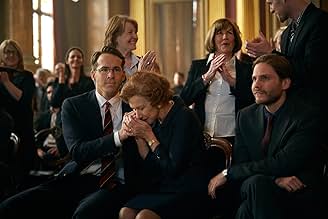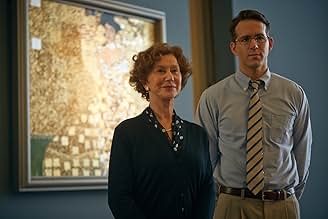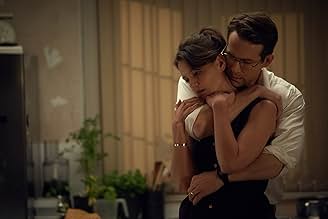IMDb-BEWERTUNG
7,3/10
65.173
IHRE BEWERTUNG
Maria Altmann, eine achtzigjährige jüdische Emigrantin, nimmt es mit der österreichischen Regierung auf, um Kunstwerke zurückzuerlangen, die ihrer Meinung nach rechtmäßig ihrer Familie gehör... Alles lesenMaria Altmann, eine achtzigjährige jüdische Emigrantin, nimmt es mit der österreichischen Regierung auf, um Kunstwerke zurückzuerlangen, die ihrer Meinung nach rechtmäßig ihrer Familie gehören.Maria Altmann, eine achtzigjährige jüdische Emigrantin, nimmt es mit der österreichischen Regierung auf, um Kunstwerke zurückzuerlangen, die ihrer Meinung nach rechtmäßig ihrer Familie gehören.
- Regie
- Drehbuch
- Hauptbesetzung
- Auszeichnungen
- 6 Nominierungen insgesamt
Empfohlene Bewertungen
This film tells the story of a old woman who moved to USA to escaped Nazi rule in Austria when she was young. She finds documentary proof in her late sister's belongings that several priceless paintings are stolen from her family, and are now in the possession of a state museum.
"Woman in Gold" is a beautiful film because it's a journey of three people working hard for a common goal for slightly different reasons. I'm impressed by the lawyer's enthusiasm in taking up Maria's case. He shows much dedication and professionalism. Maria's goal to take back the paintings is to keep memories alive, which is very touching. The atmosphere of the film is kept quite serious but not sombre, which is not easy for a film about the persecution of Jews. Overall, I think this film portrays a triumphant journey, and is very touching.
"Woman in Gold" is a beautiful film because it's a journey of three people working hard for a common goal for slightly different reasons. I'm impressed by the lawyer's enthusiasm in taking up Maria's case. He shows much dedication and professionalism. Maria's goal to take back the paintings is to keep memories alive, which is very touching. The atmosphere of the film is kept quite serious but not sombre, which is not easy for a film about the persecution of Jews. Overall, I think this film portrays a triumphant journey, and is very touching.
'Woman in Gold' makes for a dazzling movie experience (even if at times it may leave you questioning it's authenticity). Having not been an admirer of Mirren's early screen work - she seems to have become better with age (well, for me anyway), I was taken with her portrayal of Maria Altman from start to finish (as also in 'The Queen'). Ryan Reynolds gives good support as the young Lawyer taking on a case above his station. Reynolds, whose style is somewhat reminiscent of a young Kevin Costner, plays the Randol Schoenberg part with conviction.
London born director Simon Curtis gives the proceedings an easy to watch style and with the help of documentary editor Peter Lambert, they keep the viewer engaged throughout. Curtis also gets to direct his American wife (in a guest style role) Elizabeth McGovern, who has since made England her home. First time feature screenplay writer Alexi Kaye Campbell has fashioned an interesting interpretation of the writings of Altman and Schoeenberg's own life experiences, looking back at yet another of humanity's all time low past atrocities - although as mentioned, for some, certain sections of the screenplay may not always ring true (?)
Cinematographer Ross Emery (Matrix) gets a chance to prove he's also good without the help of tons of big budget CGI. It's hard to tell who did what with the music score, credited to both Martin Phipps and Hans Zimmer but, it's pleasing in an unobtrusive manor. Design Guru's, Andrew Ackland-Snow and brothers Dominic and Giles Masters (Harry Potter) with the help of others, ensure it looks good - perhaps while also getting a chance to strut their stuff without being drenched in CGI.
As a minor point, some location settings in Austria seemed a little too devoid of people to give an accurate representation, still, it's an amazing human story, both informative and entertaining. It should please most sophisticated audiences, while letting us reflect on an episode from our dark past.
London born director Simon Curtis gives the proceedings an easy to watch style and with the help of documentary editor Peter Lambert, they keep the viewer engaged throughout. Curtis also gets to direct his American wife (in a guest style role) Elizabeth McGovern, who has since made England her home. First time feature screenplay writer Alexi Kaye Campbell has fashioned an interesting interpretation of the writings of Altman and Schoeenberg's own life experiences, looking back at yet another of humanity's all time low past atrocities - although as mentioned, for some, certain sections of the screenplay may not always ring true (?)
Cinematographer Ross Emery (Matrix) gets a chance to prove he's also good without the help of tons of big budget CGI. It's hard to tell who did what with the music score, credited to both Martin Phipps and Hans Zimmer but, it's pleasing in an unobtrusive manor. Design Guru's, Andrew Ackland-Snow and brothers Dominic and Giles Masters (Harry Potter) with the help of others, ensure it looks good - perhaps while also getting a chance to strut their stuff without being drenched in CGI.
As a minor point, some location settings in Austria seemed a little too devoid of people to give an accurate representation, still, it's an amazing human story, both informative and entertaining. It should please most sophisticated audiences, while letting us reflect on an episode from our dark past.
"Mrs. Altmann, it would seem that if your case goes forward, world diplomacy will collapse, and you will be solely responsible."
"Woman in Gold" is a wonderful and sometimes touching film. Not because of the topic as this was already highlighted in "The Monuments Men", but because of the brilliant rendition Helen Mirren is showing here. A role that suits her perfectly. A distinguished elderly lady who's a descendant of a wealthy Jewish family and who was forced to flee to the United States during Austria's annexation with Germany. She left behind everything: family, personal things and valuable belongings that were owned by the family Altmann. The resentment towards the German ruler obviously is still as lively now as it was in the past. And despite her intention never to set foot on Austrian soil again, she still makes the overseas trip to reclaim the famous painting "Portrait of Adèle Bloch-Bauer" by Gustav Klimt, since she's the rightful heir. That this invaluable piece of art was worth a fortune, is swept aside by her as irrelevant. In the end the painting has been sold to a renowned New York art gallery for a mere 135 million dollars. I'm sure at that moment it wasn't irrelevant anymore.
The film is actually twofold. Obviously there's a less successful part and an exciting second part. The first part, and least successful, is about the court case Maria Altmann starts against the Austrian state, who consider the previous mentioned painting as a national treasure. The fact that it was stolen by the Nazis and actually ended up in their hands unlawfully, was a side issue apparently. So the first thing we are presented with, is an old fashioned courtroom drama with Ryan Reynolds as the young lawyer Randol Schönberg, grandson of the famous Austrian composer Arnold Schönberg and also descendant of a family of war refugees.
The fascinating and interesting part of the film focuses on the past and present of the widow Altmann. A metered mixture of images of this zestful character these days and the painful memories weighing on her shoulders. These memories are displayed in old-fashioned-looking sepia-colored flashbacks. A sketch full of contrasts of the still traumatized Maria and the conditions in which she lived during the occupation. The humiliations and fear. When she gets back in Vienna after so many years, Mary's facial expression proves that this past still weighs heavily on her.
Helen Mirren is a kind of mixture of P. L. Travers and Queen Elizabeth. A lady behaving according to the etiquette from the upper middle class who keeps certain values and norms still alive. A stiff Victorian granny who suffers from a trauma and is seeking for justice. A kind of Miss Marple, but then still in possession of an elegant well-preserved beauty. Without any effort Mirren surpasses the young Reynold on screen. Despite his immense importance in the complex legal procedure, the character pales in comparison with the engaging, witty and sometimes tragic person performed by Mirren. Despite the fact that now and then she brings forward corny sounding quotes, she remains a credible and worthy character.
Of course you can cite that the Austrian people are portrayed in a one-sided and caricatural way and look like an anti-Semitic nation that supports the Nazi-regime. Personally, I'm convinced that it's pretty close to being true and that it's more an instinctual survival tactic than that they were supporting that ideology. But that's another discussion. Maybe the relationship between Maria Altmann and her aunt Adèle could have been worked out a bit deeper. But the acting of Mirren and the tragic images of the past create an unparalleled film filled with tragedy and justice.
More reviews here : http://bit.ly/1KIdQMT
"Woman in Gold" is a wonderful and sometimes touching film. Not because of the topic as this was already highlighted in "The Monuments Men", but because of the brilliant rendition Helen Mirren is showing here. A role that suits her perfectly. A distinguished elderly lady who's a descendant of a wealthy Jewish family and who was forced to flee to the United States during Austria's annexation with Germany. She left behind everything: family, personal things and valuable belongings that were owned by the family Altmann. The resentment towards the German ruler obviously is still as lively now as it was in the past. And despite her intention never to set foot on Austrian soil again, she still makes the overseas trip to reclaim the famous painting "Portrait of Adèle Bloch-Bauer" by Gustav Klimt, since she's the rightful heir. That this invaluable piece of art was worth a fortune, is swept aside by her as irrelevant. In the end the painting has been sold to a renowned New York art gallery for a mere 135 million dollars. I'm sure at that moment it wasn't irrelevant anymore.
The film is actually twofold. Obviously there's a less successful part and an exciting second part. The first part, and least successful, is about the court case Maria Altmann starts against the Austrian state, who consider the previous mentioned painting as a national treasure. The fact that it was stolen by the Nazis and actually ended up in their hands unlawfully, was a side issue apparently. So the first thing we are presented with, is an old fashioned courtroom drama with Ryan Reynolds as the young lawyer Randol Schönberg, grandson of the famous Austrian composer Arnold Schönberg and also descendant of a family of war refugees.
The fascinating and interesting part of the film focuses on the past and present of the widow Altmann. A metered mixture of images of this zestful character these days and the painful memories weighing on her shoulders. These memories are displayed in old-fashioned-looking sepia-colored flashbacks. A sketch full of contrasts of the still traumatized Maria and the conditions in which she lived during the occupation. The humiliations and fear. When she gets back in Vienna after so many years, Mary's facial expression proves that this past still weighs heavily on her.
Helen Mirren is a kind of mixture of P. L. Travers and Queen Elizabeth. A lady behaving according to the etiquette from the upper middle class who keeps certain values and norms still alive. A stiff Victorian granny who suffers from a trauma and is seeking for justice. A kind of Miss Marple, but then still in possession of an elegant well-preserved beauty. Without any effort Mirren surpasses the young Reynold on screen. Despite his immense importance in the complex legal procedure, the character pales in comparison with the engaging, witty and sometimes tragic person performed by Mirren. Despite the fact that now and then she brings forward corny sounding quotes, she remains a credible and worthy character.
Of course you can cite that the Austrian people are portrayed in a one-sided and caricatural way and look like an anti-Semitic nation that supports the Nazi-regime. Personally, I'm convinced that it's pretty close to being true and that it's more an instinctual survival tactic than that they were supporting that ideology. But that's another discussion. Maybe the relationship between Maria Altmann and her aunt Adèle could have been worked out a bit deeper. But the acting of Mirren and the tragic images of the past create an unparalleled film filled with tragedy and justice.
More reviews here : http://bit.ly/1KIdQMT
Helen Mirren and Ryan Reynolds star in "Woman in Gold" from 2015, a true story about the quest of Maria Altmann to recover art stolen from her family by the Nazis in Vienna, the seat of anti-Semitism in Europe.
I just want to point out, to answer some of the reviews, that this is not a documentary, it's a movie. Movies combine events, change them around, omit them. No one wants to watch a tedious film that recognizes that it took a huge amount of time to get to the Supreme Court. If you want the actual, factual story of Maria Altmann's journey, you will need to read about it or see one of several documentaries. Films are meant to pique our interest.
Altmann speaks with a young attorney, Randy Shoenberg, about recovering The Woman in Gold, a painting by Klimt that is considered a symbol of Vienna. Klimt in fact painted a series of stunning portraits of Altmann's aunt, Adele Bloch-Bauer, who died of meningitis at the age of 44.
In her will, she asked her husband Ferdinand, who had seen the writing on the wall in Vienna and fled to Prague, to donate the paintings to the Austrian State Gallery.
Although he has just started a new job, Shoenberg travels to Vienna to see the will. Along the way there are flashbacks of Vienna in the '30s, where the Bloch-Bauer family lived in opulence. When the Nazis came to their home, they stripped the place of everything valuable - and there was a lot -- and put the family under house arrest.
Maria and her husband, an opera singer, manage to escape in a harrowing scene. In flashbacks, Maria is played by the remarkable Tatiana Maslany, the star of "Orphan Black," who looks incredibly like a brunette Mirren.
This is a touching, beautifully told story of one man's sacrifice and determination and a woman facing up to her past in order to seek justice.
Helen Mirren is one of my favorite actresses - here, she is a vibrant, energetic octogenarian who finds the struggle for the painting uncomfortable - several times, meeting a roadblock, she is ready to wash her hands of it, but Schoenberg won't let her. It represents her family to her, and some uncomfortable memories. You can see all of that in Mirren's multilayered performance.
Reynolds is excellent as a young man who believes in taking a chance - - he started and failed in his own law practice - and in this case, going for the gold, despite the fact that he has a wife (Katie Holmes), a baby, and one on the way, and an intolerant boss. It doesn't faze him and when Maria wants to quit, he is furious.
I disagree that there was no connection between them. In fact, there is a deep one. The quest for the painting comes to represent to him what it means to Maria
I highly recommend this film. There are tons of movies about the horrors perpetrated on Jews by the Nazis. The recovery of stolen art is one part of that horror. "You see a painting," she tells a group. "I see my aunt."
I just want to point out, to answer some of the reviews, that this is not a documentary, it's a movie. Movies combine events, change them around, omit them. No one wants to watch a tedious film that recognizes that it took a huge amount of time to get to the Supreme Court. If you want the actual, factual story of Maria Altmann's journey, you will need to read about it or see one of several documentaries. Films are meant to pique our interest.
Altmann speaks with a young attorney, Randy Shoenberg, about recovering The Woman in Gold, a painting by Klimt that is considered a symbol of Vienna. Klimt in fact painted a series of stunning portraits of Altmann's aunt, Adele Bloch-Bauer, who died of meningitis at the age of 44.
In her will, she asked her husband Ferdinand, who had seen the writing on the wall in Vienna and fled to Prague, to donate the paintings to the Austrian State Gallery.
Although he has just started a new job, Shoenberg travels to Vienna to see the will. Along the way there are flashbacks of Vienna in the '30s, where the Bloch-Bauer family lived in opulence. When the Nazis came to their home, they stripped the place of everything valuable - and there was a lot -- and put the family under house arrest.
Maria and her husband, an opera singer, manage to escape in a harrowing scene. In flashbacks, Maria is played by the remarkable Tatiana Maslany, the star of "Orphan Black," who looks incredibly like a brunette Mirren.
This is a touching, beautifully told story of one man's sacrifice and determination and a woman facing up to her past in order to seek justice.
Helen Mirren is one of my favorite actresses - here, she is a vibrant, energetic octogenarian who finds the struggle for the painting uncomfortable - several times, meeting a roadblock, she is ready to wash her hands of it, but Schoenberg won't let her. It represents her family to her, and some uncomfortable memories. You can see all of that in Mirren's multilayered performance.
Reynolds is excellent as a young man who believes in taking a chance - - he started and failed in his own law practice - and in this case, going for the gold, despite the fact that he has a wife (Katie Holmes), a baby, and one on the way, and an intolerant boss. It doesn't faze him and when Maria wants to quit, he is furious.
I disagree that there was no connection between them. In fact, there is a deep one. The quest for the painting comes to represent to him what it means to Maria
I highly recommend this film. There are tons of movies about the horrors perpetrated on Jews by the Nazis. The recovery of stolen art is one part of that horror. "You see a painting," she tells a group. "I see my aunt."
The lady in question is Adele Bloch-Bauer who was the subject of a magnificent painting, deploying lots of gold, by the Austrian artist Gustav Klimt. Following the Anschuss of 1938 when Germany took over Austria, this painting was one of many, many artefacts seized by the Nazis from Jewish families in occupied Europe.
The film tells the story - a little fictionalised - of Adele's niece Maria Altmann who escaped from Vienna to live in California and, during the 1980s as an octogenarian, pursued an audacious claim to take back this painting and other Klimt works from the Austrian Government. Helen Mirren is brilliant as Altmann in another distinguished performance in a sparkling career during which she has played everything from "The Queen" to an assassin (RED"), while Ryan Reynolds is surprisingly good as her lawyer Randy Schoenberg in a role a million miles from "Green Lantern" or "Deadpool".
There's a lot going on in this film: legal battles over the art work with some classic courtroom scenes, flashbacks (in sepia colours) to Altmann's earlier life in 1930s Vienna, and an evolving relationship between the irascible Altmann and the idealistic Schoenberg, both descendants of famous Austrians. This is not the kind of film that was ever going to be a major box office draw but it is certainly worth a home viewing.
The film tells the story - a little fictionalised - of Adele's niece Maria Altmann who escaped from Vienna to live in California and, during the 1980s as an octogenarian, pursued an audacious claim to take back this painting and other Klimt works from the Austrian Government. Helen Mirren is brilliant as Altmann in another distinguished performance in a sparkling career during which she has played everything from "The Queen" to an assassin (RED"), while Ryan Reynolds is surprisingly good as her lawyer Randy Schoenberg in a role a million miles from "Green Lantern" or "Deadpool".
There's a lot going on in this film: legal battles over the art work with some classic courtroom scenes, flashbacks (in sepia colours) to Altmann's earlier life in 1930s Vienna, and an evolving relationship between the irascible Altmann and the idealistic Schoenberg, both descendants of famous Austrians. This is not the kind of film that was ever going to be a major box office draw but it is certainly worth a home viewing.
Wusstest du schon
- WissenswertesOprah Winfrey was, for ten years, the owner of Gustav Klimt's second-most-famous portrait of the subject of the painting unofficially known as "Woman in Gold." The second most famous Klimt portrait of Bloch-Bauer was officially titled "Adele Bloch-Bauer ll." Winfrey reportedly bought the painting anonymously in 2006, when Christie's sold it at auction for $87.9 million, during the same auction session when the subject of this film was sold, along with four other Klimt paintings owned by Maria Altmann's family. In 2016, Winfrey sold the 54"x54" painting, "Adele Bloch-Bauer II," to a Chinese collector for $150 million.
- PatzerWhen Randy Schoenberg is before the Supreme Court, he is shown being asked a convoluted question by Chief Justice William Rehnquist, whereupon Schoenberg admits he doesn't understand it. That question was actually posed by Justice David Souter. The reaction from the other justices, who also didn't understand the question, was accurately depicted.
- Zitate
Randol Schoenberg: It's hard to believe Hitler once applied to be an art student here.
Maria Altmann: I wish they'd have accepted him.
- VerbindungenEdited into The Spoils (2024)
Top-Auswahl
Melde dich zum Bewerten an und greife auf die Watchlist für personalisierte Empfehlungen zu.
- How long is Woman in Gold?Powered by Alexa
Details
- Erscheinungsdatum
- Herkunftsländer
- Offizielle Standorte
- Sprachen
- Auch bekannt als
- La dama de oro
- Drehorte
- Produktionsfirmen
- Weitere beteiligte Unternehmen bei IMDbPro anzeigen
Box Office
- Budget
- 11.000.000 $ (geschätzt)
- Bruttoertrag in den USA und Kanada
- 33.307.793 $
- Eröffnungswochenende in den USA und in Kanada
- 2.091.551 $
- 5. Apr. 2015
- Weltweiter Bruttoertrag
- 61.619.773 $
- Laufzeit1 Stunde 49 Minuten
- Farbe
- Sound-Mix
- Seitenverhältnis
- 2.35 : 1
Zu dieser Seite beitragen
Bearbeitung vorschlagen oder fehlenden Inhalt hinzufügen

Oberste Lücke
By what name was Die Frau in Gold (2015) officially released in India in English?
Antwort







































